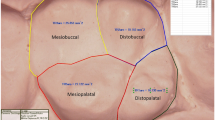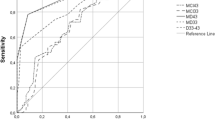Abstract
Background
Sex determination is an important step in establishing the biological profile of unidentified human remains.
Aim
The aims of the study were, firstly, to assess the degree of sexual dimorphism in permanent teeth, based on digital tooth measurements performed on panoramic radiographs. Secondly, to identify sex-related tooth position-specific measurements or combinations of such measurements, and to assess their applicability for potential sex determination.
Materials and methods
Two hundred digital panoramic radiographs (100 males, 100 females; age range 22–34 years) were retrospectively collected from the dental clinic files of the Dentomaxillofacial Radiology Center of the University Hospitals Leuven, Belgium, and imported in image enhancement software. Tooth length- and width-related variables were measured on all teeth in upper and lower left quadrant, and ratios of variables were calculated. Univariate and multivariate analyses were performed to quantify the sex discriminative value of the tooth position-specific variables and their combinations.
Results
The mandibular and maxillary canine showed the greatest sexual dimorphism, and tooth length variables had the highest discriminative potential. Compared to single variables, combining variables or ratios of variables did not improve substantially the discrimination between males and females.
Discussions and conclusions
Considering that the discriminative ability values (area under the curve (AUC)) were not higher than 0.80, it is not advocated to use the currently studied dental variables for accurate sex estimation in forensic practice.


Similar content being viewed by others
References
Joseph AP, Harish RK, Rajeesh Mohammed PK, Vinod Kumar RB (2013) How reliable is sex differentiation from teeth measurements. Oral Maxillofac Pathol J 4(1):289–292
DVI Guide (2014) INTERPOL 2014
Pretty IA, Sweet D (2001) A look at forensic dentistry—Part 1: the role of teeth in the determination of human identity. Br Dent J 190(7):359–366
Rai B, Kaur J (2013) Evidence-based forensic dentistry. Springer, Berlin Heidelberg
Singh NN, Gowhar O, Ain TS, Sultan S (2014) Exploring trends in forensic odontology. J Clin Diagn Res 8(12):ZC28–ZC30
Senn DR, Weems RA (2013) Manual of forensic odontology, 5th edn. CRC Press, Taylor & Francis Group, Boca Raton
Carvalho SP, Brito LM, Paiva LA, Bicudo LA, Crosato EM, Oliveira RN (2013) Validation of a physical anthropology methodology using mandibles for gender estimation in a Brazilian population. J Appl Oral Sci 21(4):358–362
Rötzscher K (2014) Forensic and legal dentistry. Springer International Publishing, Switzerland
Gupta A, Kumar K, Shetty DC, Wadhwan V, Jain A, Khanna KS (2014) Stature and gender determination and their correlation using odontometry and skull anthropometry. J Forensic Dent Sci 6(2):101–106
Thapar R, Angadi PV, Hallikerimath S, Kale AD (2012) Sex assessment using odontometry and cranial anthropometry: evaluation in an Indian sample. Forensic Sci Med Pathol 8(2):94–100
Moreno-Gómez F (2013) Sexual dimorphism in human teeth from dental morphology and dimensions: a dental anthropology viewpoint. In. doi:http://dx.doi.org/10.5772/55881
Eboh DEO (2012) A dimorphic study of maxillary first molar crown dimensions of urhobos in Abraka, South-Southern Nigeria. J Morphol Sci 2:96–100
Parekh DH, Patel SV, Zalawadia AZ, Patel SM (2012) Odontometric study of maxillary canine teeth to establish sexual dimorphism in Gujarat population. Int J Biol Med Res 3(3):1935–1937
Khangura RK, Sircar K, Singh S, Rastogi V (2011) Sex determination using mesiodistal dimension of permanent maxillary incisors and canines. J Forensic Dent Sci Jul-Dec 3(2):81–85
da Costa YTF, Lima LNC, Rabello PM (2012) Analysis of canine dimorphism in the estimation of sex. Braz J Oral Sci 11(3):406–410
Mujib ABR, Tarigoppula RKVN, Kulkarni PG, Anil BS (2014) Gender determination using diagonal measurements of maxillary molar and canine teeth in Davangere population. J Clin Diagn Res 8(11):141–144
Prabhu S, Acharya AB (2009) Odontometric sex assessment in Indians. Forensic Sci Int 192:129.e121–129.e125
Shireen A, Ara SA, Azzeghaiby SN, Alzoghaibi I, Tarakji B, Umair A (2014) Sex determination potential from canine tooth dimensions. Br J Med Med Res 4(32):5133–5143
Sabóia TM, Tannure PN, Luiz RR, Costa MC, Granjeiro JM, Küchler EC, Antunes LS (2013) Sexual dimorphism involved in the mesiodistal and buccolingual dimensions of permanent teeth. Dentistry 3000 1(1). doi:10.5195/d3000.2013.10
Mitsea AG, Moraitis K, Leon G, Nicopoulou-Karayianni K, Spiliopoulou C (2014) Sex determination by tooth size in a sample of Greek population. Homo 65(4):322–329
Filipović G, Radojičić J, Stošić M, Janošević P, Ajduković Z (2013) Odontometric analysis of permanent canines in gender determination. Arch Biol Sci 65(4):1279–1283. doi:10.2298/ABS1304279F
Brook AH, Griffin RC, Townsend G, Levisianos Y, Russell J, Smith RN (2007) Variability and patterning in permanent tooth size of four human ethnic groups. Suppl Arch Oral Biol (Nov 2007) 54:S79–S85
Lakhanpal M, Gupta N, Rao NC, Vashisth S (2013) Tooth dimension variations as a gender determinant in permanent maxillary teeth. JSM Dent 1(1):1014
Angadi PV, Hemani S, Prabhu S, Acharya AB (2013) Analyses of odontometric sexual dimorphism and sex assessment accuracy on a large sample. J Forensic Leg Med 20(6):673–677
Zorba E, Moraitis K, Eliopoulos C, Spiliopoulou C (2012) Sex determination in modern Greeks using diagonal measurements of molar teeth. Forensic Sci Int 217:19–26
Zorba E, Moraitis K, Manolis SK (2011) Sexual dimorphism in permanent teeth of modern Greeks. Forensic Sci Int 210:74–81
Viciano J, López-Lázaro S, Alemán I (2013) Sex estimation based on deciduous and permanent dentition in a contemporary Spanish population. Am J Phys Anthropol 152(1):31–43
Rai B, Anand SC (2007) Gender determination by diagonal distances of teeth. The Internet Journal of Biological Anthropology 1. Article available from: http://ispub.com/IJBA/1/1/11991
Acharya AB, Angadi PV, Prabhu S, Nagnur S (2011) Validity of the mandibular canine index (MCI) in sex prediction: reassessment in an Indian sample. Forensic Sci Int 204(1-3):e1–e4
Rao NG, Pai ML, Rao NN, Rao KTS (1988) Mandibular canine in establishing sex identity. J Indian Forensic Med 10:5–12
Rao NG, Rao NN, Pai ML, Kotian MS (1989) Mandibular canine index—a clue for establishing sex identity. Forensic Sci Int 42:249–254
Doris JM, Bernard BW, Kuftinec MM, Stom D (1981) A biometric study of tooth size and dental crowding. Am J Orthod 79:326–336
Rushton VE, Horner K (1996) The use of panoramic radiology in dental practice. J Dent 24(3):185–201
Al-Shammari AF, Mohammed RK, Abed WM (2008) Estimation of real distance between two points in computer aided X-ray dental image of Planmeca Proline PC with Dimax device. J Bagh College Dentistry 20(2):98–103
Yitschaky M, Haviv Y, Aframian DJ, Abed Y, Redlich M (2004) Prediction of premolar tooth lengths based on their panoramic radiographic lengths. Dentomaxillofacial Radiol 33:370–372
Teixeira VP, Rodrigues DB, Reis MA, Castro EC, Piccioni DE, Beghini M, de Lima Pereira SA (2013) Comparison of the total length and areas of upper central incisor between males and females using computer-assisted morphometry. Anat Sci Int 88:130–133
Thevissen P (2013) Dental age estimation in sub-adults: striving for an optimal approach. Leuven University Press, Leuven, Belgium
Benjamini Y, Hochberg Y (1995) Controlling the false discovery rate: a practical and powerful approach to multiple testing. J R Stat Soc 57:289–300
Ohba T, Katayama H (1972) Comparison of orthopantomography with conventional periapical dental radiography. Oral Surg 34(3):525–530
Adler CJ, Donlon D (2010) Sexual dimorphism in deciduous crown traits of a European derived Australian sample. Forensic Sci Int 199(1-3):29–37
Schwartz GT, Dean MC (2005) Sexual dimorphism in modern human permanent teeth. Am J Phys Anthropol 128(2):312–317
Ferrario VF, Sforza C, Tartaglia GM, Colombo A, Serrao G (1999) Size and shape of the human first permanent molar: a Fourier analysis of the occlusal and equatorial outlines. Am J Phys Anthropol 108(3):281–294
Johanson G (1971) Age determinations from human teeth. Odontologisk Revy 22 (21):1-126
Lambrechts P, Braem M, Vuylsteke-Wauters M, Vanherle G (1989) Quantitative in vivo wear of human enamel. J Dent Res 68(12):1752–1754
Van’t Spijker A, Rodriguez JM, Kreulen CM, Bronkhorst EM, Bartlett DW, Creugers NHJ (2009) Prevalence of tooth wear in adults. Int J Prosthodont 2(1):151–158
Dabbs G (2010) Sex determination using the scapula in New Kingdom skeletons from Tell El-Amarna. Homo 61(6):413–420
Giurazza F, Schena E, Del Vescovo R, Cazzato RL, Mortato L, Saccomandi P, Paternostro F, Onofri L, Zobel BB (2013) Sex determination from scapular length measurements by CT scans images in a Caucasian population. Conf Proc IEEE Eng Med Biol Soc 1632-1635. doi:10.1109/EMBC.2013.6609829, PMID:24110016
Ekizoglu O, Hocaoglu E, Inci E, Bilgili MG, Solmaz D, Erdil I, Can IO (2014) Sex estimation from sternal measurements using multidetector computed tomography. Med (Baltimore) 93(27):e240. doi:10.1097/MD.0000000000000240
Kranioti EF, Nathena D, Michalodimitrakis M (2011) Sex estimation of the Cretan humerus: a digital radiometric study. Int J Legal Med 125(5):659–667
Kanz F, Fitzl C, Vlcek A, Frommlet F (2015) Sex estimation using the femur of Austrians born in the 19th to the middle of the 20th century. Anthropol Anz 72(1):117–127
Iscan MY (2005) Forensic anthropology of sex and body size. Forensic Sci Int 147:107–112
Williams BA, Rogers T (2006) Evaluating the accuracy and precision of cranial morphological traits for sex determination. J Forensic Sci 51(4):729–735
Papaioannou VA, Kranioti EF, Joveneaux P, Nathena D, Michalodimitrakis M (2012) Sexual dimorphism of the scapula and the clavicle in a contemporary Greek population: applications in forensic identification. Forensic Sci Int 217(1-3):231–237
Clavero A, Salicrú M, Turbón D (2015) Sex prediction from the femur and hip bone using a sample of CT images from a Spanish population. Int J Legal Med 129(2):373–383
Durić M, Rakocević Z, Donić D (2005) The reliability of sex determination of skeletons from forensic context in the Balkans. Forensic Sci Int 147(2-3):159–164
Bruzek J (2002) A method for visual determination of sex, using the human hip bone. J Phys Anthropol 117:157–168
Dhall JK, Kapoor AK (2015) Fingerprint ridge density as a potential forensic anthropological tool for sex identification. J Forensic Sci 61(2):424–429
Álvarez-Sandoval BA, Manzanilla LR, Montiel R (2014) Sex determination in highly fragmented human DNA by high-resolution melting (HRM) analysis. PLoS One 9(8):9
Author information
Authors and Affiliations
Corresponding author
Rights and permissions
About this article
Cite this article
Capitaneanu, C., Willems, G., Jacobs, R. et al. Sex estimation based on tooth measurements using panoramic radiographs. Int J Legal Med 131, 813–821 (2017). https://doi.org/10.1007/s00414-016-1434-0
Received:
Accepted:
Published:
Issue Date:
DOI: https://doi.org/10.1007/s00414-016-1434-0




